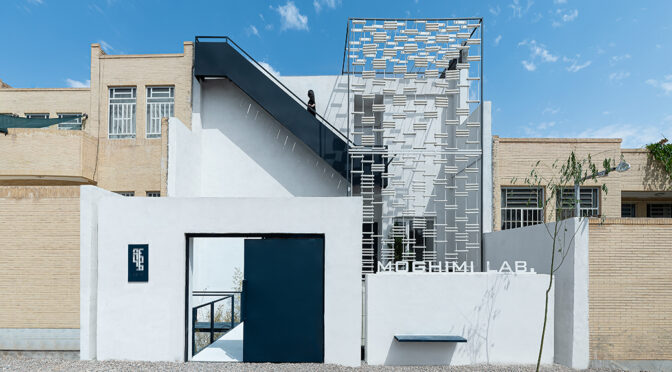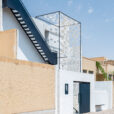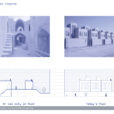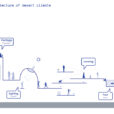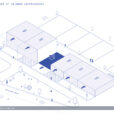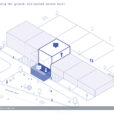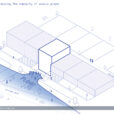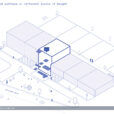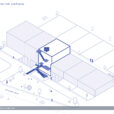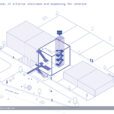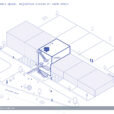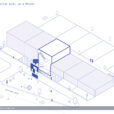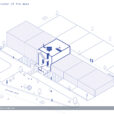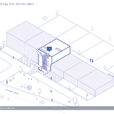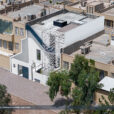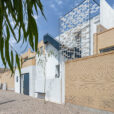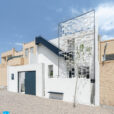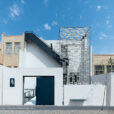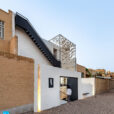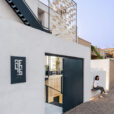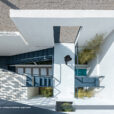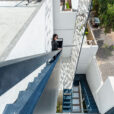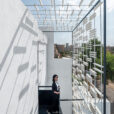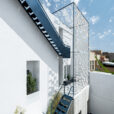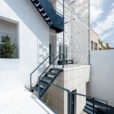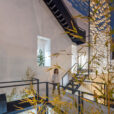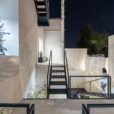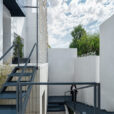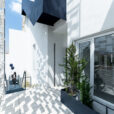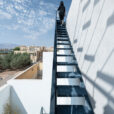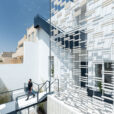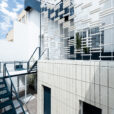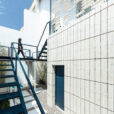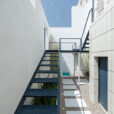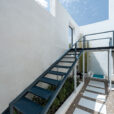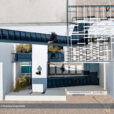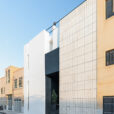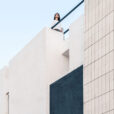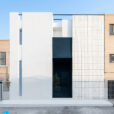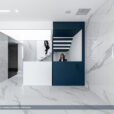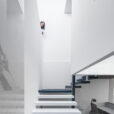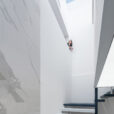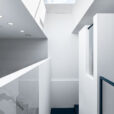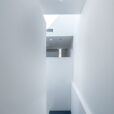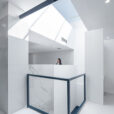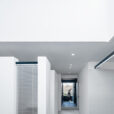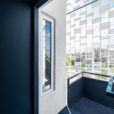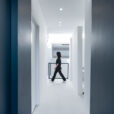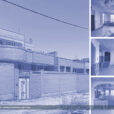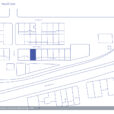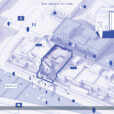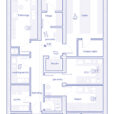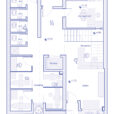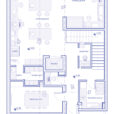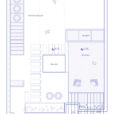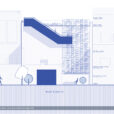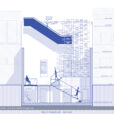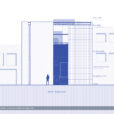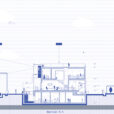ماشین گفتمان شهری
دفتر طراحی درک فضا (مهیار جمشیدی)
موقعیت: یزد، ایران
تاریخ: ۱۴۰۲
مساحت: ۴۵۰ مترمربع
وضعیت: ساختهشده
کارفرما: آقای مقیمی
تیم طراحی: حانیه دانشور، بهاره پزشکی، فاطمه حسنلو
سازه و تاسیسات: آقای عمادی، آقای اکبرپوریان، آقای مردانی
اجرا و نظارت: سعید بخشی
گرافیک: بیتا رضایی، امیرحسین محمد، رومینا قورچیان، ملیکا علیقلیزاده
عکس: محمدحسین حمزهلویی
اکثر ساختوسازهای اخیر شهر یزد آن را به سمت دوپارهشدن بافت جدید و قدیم نزدیک کردهاند و رشد بیرویه بافت جدید سبب شده که معماری یزد از معانی پویای گذشته خود فاصله بگیرد و به یک معماری منزوی گرایش پیدا کند، نوعی برداشت غلط از معماری گذشته که بر درونگرایی و انزوا در تمامی کارکردهای معماری پافشاری دارد. محل قرارگیری پروژه ما در منطقه صفائیه، یکی از همین بافتهای جدید شهر یزد است که اکثر ساختمانهای همجوار بهصورت تیپ، تکمتریال و بدون دیالوگ با شهر هستند؛ جدارههای مرزی ساختمانها و خیابان که حدودا چهار متر ارتفاع دارند، تماما صلباند و امکان ارتباط بصری عابران و مردم شهر با بناها را به حداقل میرسانند. با توجه به این اوضاع، در این پروژه سعی شد با ریشهیابی مفاهیم معماری گذشته یزد، بازتعریفی نو از آنها داده شود.
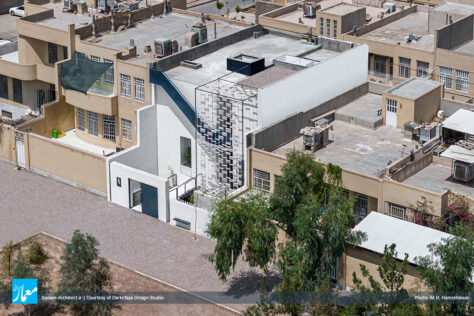
خواسته کارفرما بازسازی سطحی داخلی یک ساختمان مسکونی سهواحدی و فراهمآوردن امکان بهرهبرداری از آن به عنوان یک آزمایشگاه بود، و در ابتدای پروژه، بحثی از نماسازی وجود نداشت. از اینرو، در جلسات متوالی با کارفرما تلاش شد تا از تمامی پتانسیلهای بنای موجود استفاده شود، از جمله این ایده که بهجای استفاده از یک تابلو برای شناسایی عملکرد ساختمان در شهر، میتوان از نمایی استفاده کرد که حجم کلی آن همانند تابلویی بزرگ (به ابعاد ۸ در ۱۲ متر)، هویتش را در شهر فریاد بزند و برای مردم شهر دستیافتنی و دوستداشتنی باشد، در جریان پروژه محقق شد.

پروژه حاضر ماشینی است در پاسخ به عملکردهای درونی مورد نیاز خود به عنوان یک آزمایشگاه کامل، و همزمان واجد هویتی دوگانه است؛ از یکسو (سمت بلوار اصلی)، در تلاش برای گفتوگو با شهر و مردمانش، دارای یک هویت برونگراست که میکوشد خود را به شهر بشناساند و برای مردمانش دستیافتنی باشد، و از سوی دیگر (سمت خیابان ششمتری اول)، یک ساختمان درونگراست که در تلاش برای حفظ آرامش کوچه مسکونی و احترام به همسایگان خود است. این هویت دوگانه از آنجا به وجود آمد که بخشهای خصوصیتر نیازمند نوعی خلوت و درونگرایی در کنار یک حجم خالص و بیآلایش هستند، و فضاهای جمعی و عمومی، همانند محلهها و میادین گذشته، پرکارتر و در تلاش برای برقراری تعامل با مردم شهر هستند.
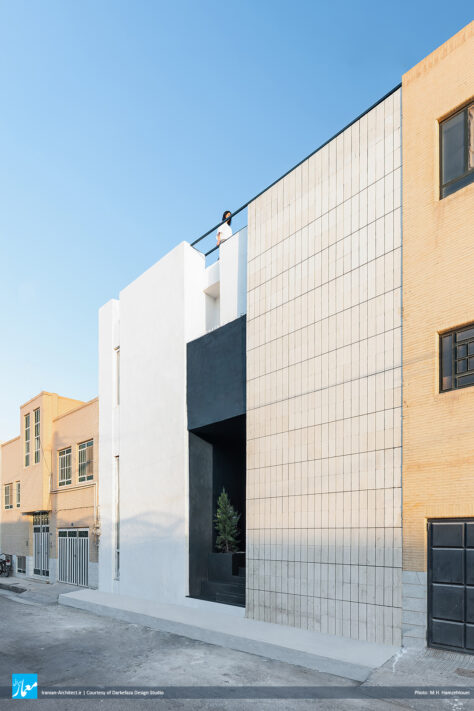
کاویدن زمین و دستیابی به یک حیاط با حجمی دو برابر قبل (بهجای حیاط کوچک جلوخان بنای موجود)، پروژه را به سمت ایجاد یک پلازای شهری کوچکمقیاس و بخشیدن فضایی به مردمان شهر پیش برد. این پلازا نیازمند یک جداره ایوانگونه و دعوتکننده بود که در پس روزنهایش و سکوی پیش روی خود (پیرنشین)، برای مردم ملموس باشد. از اینرو، ساختار کلی حجم ساختمان در ضلع رو به بلوار، پویا، پرکار، دعوتکننده و بهیادماندنی است؛ هویتی خاص در این نما از ساختمان تجلی میکند که تمامی ریشههای آن از موتیفها و معانی معماری گذشته بستر موجود گرفته شده است.
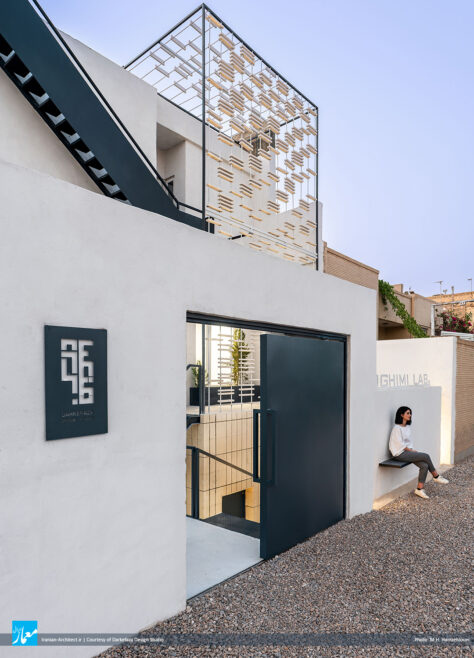
بنای موجود یک ساختمان با مصالح بنایی و دیوارهای باربر بود، و در میانه دو آکس از دیوارهای باربر، یک دستگاه پله دوطرفه غیراستاندارد وجود داشت که ساختمان را به دو بخش کلی (شرقی و غربی) تقسیم کرده بود، معضلی که امکان گستردگی و یکپارچگی فضا را که ویژگی فضایی مورد نیاز سالن کار فنی یک آزمایشگاه است، از ما میگرفت. از اینرو، در ابتدا تلاش کردیم با حذف این عنصر مزاحم، به فضایی یکپارچهتر برسیم، و این امر نیازمند تقویت سازهای و الحاق یک سازه فلزی به سازه موجود مصالح بنایی پروژه (تیر و ستون آهنی در انتهای انقطاع دیوار باربر) بود.
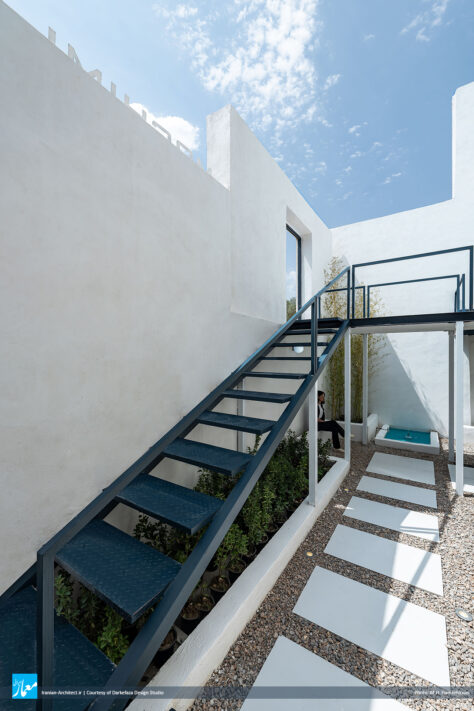
راهپله پروژه از یک دستگاه یکپارچه که سدی در میانه ساختمان بود، به چند ابژه فضاساز مستقل، و در نتیجه، به عنصر اصلی پویایی بنا تبدیل شده است. در نخستین مورد، ارتباط عمودی بین طبقه همکف و زیرزمین از طریق یک پله خطی چسبیده به جداره ایوان شهری میسر میشود که از قضا، این پله در بخشی از ساختمان است که متعلق به مردم است و با پلازای شهری کوچک پروژه کار میکند. فضایی که در زیر این پله و پل مجاورش به وجود آمده، بخشی از یک گودالباغچه است که به دلیل حضور عناصر طبیعی مثل آب، خاک، درختان و گیاهان، فضایی روحبخش و باکیفیت برای انتظار استفادهکنندگان بنا به شمار میرود و همزمان میتواند فضایی مطلوب برای حضور و فراغت عموم مردم باشد.

ارتباط عمودی طبقه همکف با طبقه اول از طریق پلکانی مجزا در لابی انتظار اصلی پروژه برقرار میشود؛ این پله که تعریفکننده بخش پذیرش آزمایشگاه است، با نورگیرهای سقفی بنا نیز کار میکند. این نورگیرها در فضای کریدور اصلی، مجاور سالن کار و اتاق جلسات، بهجای پنجرههای رو به بیرون، بخشی از آسمان را متعلق به پروژه میکنند و ضمن فراهمکردن نور کامل و مکفی برای این طبقه، کمترین گرما را به فضای داخل انتقال میدهند؛ آنها با قطع ارتباط بنا با شهر در بخش فنی، حواسپرتی کارشناسان آزمایشگاه را به حداقل میرسانند و در عین حال منجر به احترام بیشتر به همسایگان مسکونی کوچه میشوند.
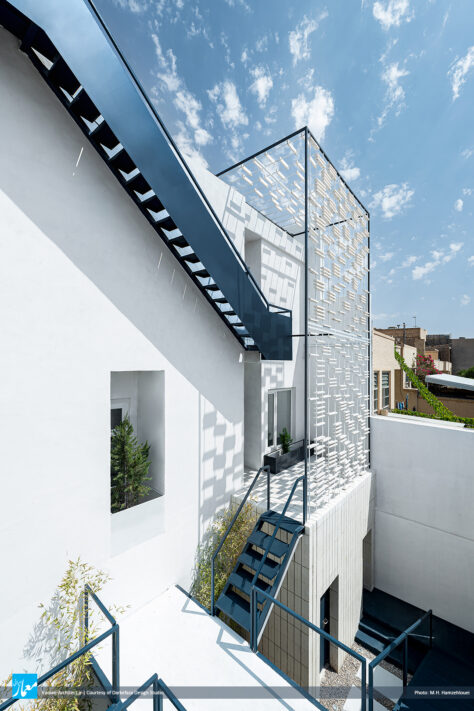
پله ارتباط طبقه اول با پشتبام که روفباکس و بخش تاسیساتی را در خود جای داده، چسبیده به جداره نماست و خود به عنصری شاخص برای نمای پروژه بدل شده است که پویایی ساختمان را برای شهر هویدا میسازد و همزمان کیفیت فضایی متفاوتی را برای استفادهکننده خود ایجاد میکند. این پله نظرگاهی به شهر است که امکان راهرفتن روی جداره بنا را نیز میسر میسازد، یک تجربه زیستی جدید که ریشههای آن در گذشته بستر پروژه، یعنی پلکان جدارههای نماهای شهر سریزد وجود دارد. سریزد یک شهر دو طبقه است که به ما نشان میدهد پویایی و حرکت در شهرسازی و معماری قدیم این بستر وجود داشته است.
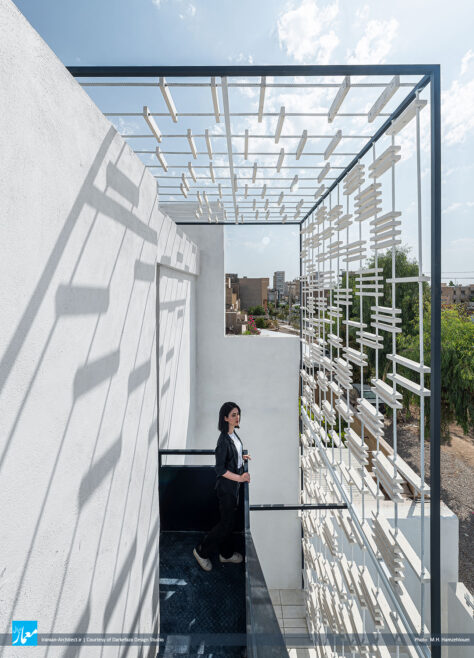
پوسته مشبک ایوانگونه نمای اصلی پروژه دارای یک ساختار سبک و بافتهشده است که الگوی آجری آن به نحوی طراحی شده است که رویکردی جدید به استفاده از این مصالح بومی در نماهای شهری باشد. بهطور کلی، خلوص و سادگی مصالح پروژه، همانند بافت یکدست رویه، جداره و سازه در معماری سریزد، حواس بیننده را سریعا به موضوع اصلی ایده سوق میدهد و به این ترتیب، ذهن در پی شلوغی پدیدههای متعدد و مجزا نمیرود. در واقع، فرد در تعامل با این پروژه، به فهم خود از بنا میاندیشد، نه به جزئیات مصالح.
Urban Discourse Machine
Darkefaza Design Studio (Mahyar Jamshidi)
Location: Yazd, Iran
Date: 2023
Area: 450 sqm
Status: Completed
Client: Mr. Moghimi
Design Team: Hanieh Daneshvar, Bahareh Pezeshki, Fatemeh Hasanloo
Structure & MEP Engineering: Mr. Emadi, Mr. Akbarpourian, Mr. Mardani
Construction & Supervision: Saeed Bakhshi
Graphic: Bita Rezaee, Amirhossein Mohammad, Romina Ghourchian, Melika Aligholizadeh
Photo: M.H. Hamzehlouei
The recent constructions in Yazd (located in Iran) have brought this city closer to a division between the old urban fabric and the modern one. The excessive growth of the modern fabric has caused the architecture of Yazd to move away from its dynamic meanings and turn into an isolated architecture. This project is located in Safayieh region in Yazd, which is one of those modern urban fabrics in this city. Most of the constructions in this area are single material with the same form and without any dialogue to be made with the city. The separator walls of these buildings in the street are all the same height and also, they are all solid in material with no transparency, no matter the function of the building. Because of that the possibility of visual communication of passers and people with the buildings are very low and minimum. Considering this situation, in this project, an attempt was made to re-define the past architectural concepts of Yazd, by finding the roots of its traditional architecture of historical fabric.
The client’s request for the project was a simple interior renovation of a three-story building for the function of laboratory. In consecutive meetings with the client, some efforts were made to use all the potentials of the existing building. In the beginning, there was no discussion of facade design; But during the design process, we reached to a point that instead of using a sign to identify the function of this building, its facade could be the perfect alternative to shout the identity of the building and be accessible to the city people.
The project is a machine in response to its internal functions (a complete laboratory), and at the same time, it has a dual identity, which on the one hand (south side), it is an extroverted creature, trying to communicate with the city and its people, in order to be known to the city and accessible to its people, and on the other hand (north side), it is an introverted building which is trying to maintain the peace of the residential alley and respect its neighbors. This dual identity arose from the fact that the private zones need a privacy and introversion in addition to the overall purity of their uncontaminated mass; and on the other hand, the public spaces are more detailed, and they are trying to interact with the people of the city.
Excavating the land and achieving a yard with twice the volume of the previous one (instead of the small yard in front of the existing building), moved the project towards creating a small-scale urban plaza and giving space to the people of the city. This plaza needed an inviting wall that would be tangible for people, behind its openings and the platform in front of it (frontage seating). Therefore, the general structure of the building facade on the south side is dynamic, inviting and memorable; a special identity is manifested in this facade of the building, which all of its roots are taken from the motifs and meanings of the past architecture of the context.
The existing building had the bearing wall system structure, and between its two structural axes, there was a non-standard two-way staircase that divided the building into two general parts (east and west). This problem deprived us of the possibility of expansion and integration of the space, which was so vital spatial feature for a lab workstation. Therefore, at first, an attempt was made to remove this disturbing element, in order to reach a more integrated space. This required structural strengthening and addition of a metal structure to the existing bearing wall of the project.
The staircase of the project has turned from an integrated object that was a barrier in the middle of the building, into several independent space-making objects, and as a result, it has become the main dynamic element of the building. The vertical connection between the ground floor and the basement is possible through a linear staircase attached to the wall of the urban porch, which is in the part of the building that belongs to the people and works with its small urban plaza. The space created under this staircase and the adjacent bridge is a part of a sunken court, which due its natural elements such as water, soil, trees and plants, is considered a high-quality and soulful space for waiting time of the lab’s users, and at the same time, it can be a favorable space for the people of the city to relax .
The vertical connection of the ground floor to the first floor is established through a separate staircase in the main waiting lobby of the project. This staircase defines the reception area of the laboratory and deals with the ceiling skylights of the building. These skylights in the main corridor space, adjacent to the work hall and meeting room, make part of the sky belong to this project, and while providing complete and sufficient light for this floor, they transfer the least amount of heat to the interior space. By disconnecting the building from the city in the technical part, they minimize the distraction of the laboratory experts, and at the same time, they bring more respect for the residential neighbors of the street.
The staircase connecting the first floor with the roof (including the roof box and utility area) is attached to the facade wall, and has become an important element for the project facade, which shows the dynamics of the building, and at the same time, creates a different spatial quality for its users. This staircase is a place for observation of the city that also enables walking on the wall of the building, a new experience that has its roots in the past of the project’s context, that is, the stairs of the facades of the city of Saryazd. Saryazd is a two-story city, which shows us that there was dynamism and movement in the old urban planning and architecture of this context.
The mesh skin of the main facade of the project has a light and woven structure, whose its brick pattern is designed in a way that is a new approach to the use of these native materials in urban facades. The purity and simplicity of the project’s materials, like the integrity of the surface, wall and structure in the architecture of Saryazd, quickly draws the viewer’s attention to the main theme of the idea, and in this way, the mind does not follow the numerous and separate phenomena. In fact, when interacting with the project, a person thinks about his understanding of the building, not about the details of the materials.

